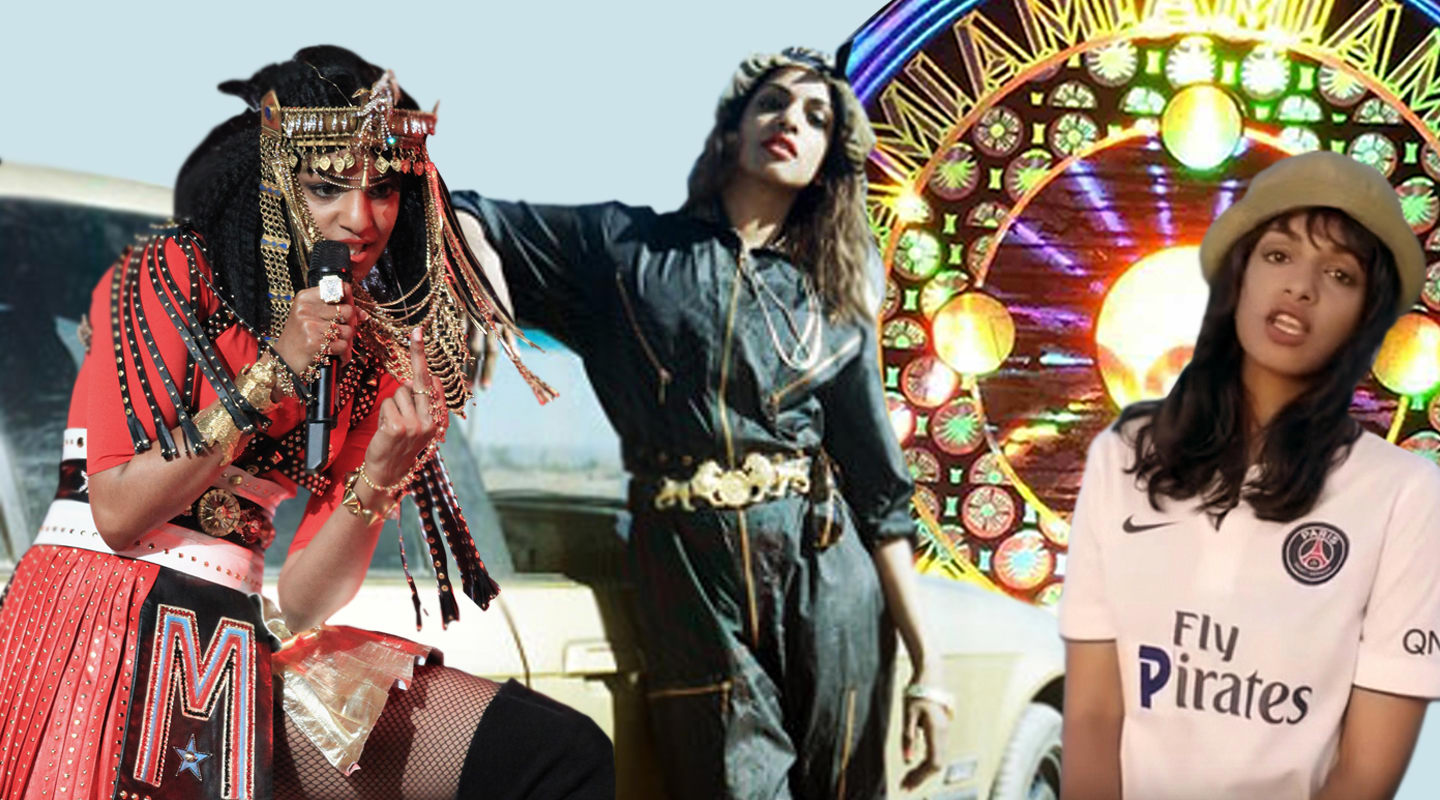 Left photo via Getty, center and right images courtesy of M.I.A/Interscope
Left photo via Getty, center and right images courtesy of M.I.A/Interscope
The last, most public example of a pop star aggravating a brand that I recall was back in 2014, when M.I.A gave the finger to millions of American living rooms during the Super Bowl half-time show, shocking the family-friendly NFL who had just got over Janet Jackson’s nipple-gate. Regardless of whether the NFL's subsequent outrage was due to her gesture itself, or the advertising revenue potentially being compromised (after all, a half-time Super Bowl commercial sells for $5 million), the brand made it clear that her behavior wouldn’t be tolerated.
Now, she’s being made an example of again, because of a T-shirt in her music video for "Borders." In it, she wears a Paris Saint German (PSG) football shirt, whose logo from its sponsors, Fly Emirates, is doctored to read ‘Fly Pirates.’ M.I.A leaked their response on Twitter, a four page document that had been sent to her team back on December 14, threatening potential legal consequences. The letter refers to “harm we have suffered” and attempts to personify the brand by using terms like "image prejudice" and “protection.” They note, “More than being surprised, we simply do not understand why we are associated, through our logo and the official jersey of our team's players, to such denunciation."
They might have reason to have their feelings so hurt. Brands in 2016 are unused to challenge by pop stars, in a climate where corporate co-signs often reap larger financial rewards than album sales. (Rihanna's deal with Samsung for ANTIdiary, estimated at $25 million, comes to mind, while Mariah Carey has reportedly signed a seven figure deal to endorse mobile app Game Of War.) Brands are even less used to forced associations with real world issues, and in this context, we’re witnessing a display of true defiance. To PSG, M.I.A has committed the cardinal sin—and by disregarding the messianic power of the brand, she’s exposed herself to the wrath of a monolith.
Since Naomi Klein argued that global corporate branding had successfully commodified youth culture back in 1999 with her seminal book No Logo: Taking Aim at the Brand Bullies, we’ve known that resisting brand saturation is futile. Their symbols, are after all, universally acknowledged in a way that the crises M.I.A is trying to highlight—in this case of conflict refugees crossing borders—are not.
So what is the point she’s making by overstepping the invisible boundaries? One, that in the context of football, borders don't matter, and drafting in players from conflict zones to secure huge amounts of money provides a depressing double standard. (Something PSG—and other teams—do, a hypocrisy M.I.A has called out on Twitter.) This selling of foreign bodies in the sports world expertly selects who is let in and who is kept out.
Her reference to ‘pirate’ is a clear satire of the term. The official description, of “someone who robs the sea or plunders the land without having a commission from a sovereign nation” is steeped in semantics. Here, the robbery might refer to that of lives and identity, crimes against humanity that only strike a chord when a toddler is washed up at sea (as in the case of Aylan Kurdi last year, whose image was projected on front covers across the world). The knowing wink at the media panic about incoming plunderers of state benefits and resource is especially damning here, reinforcing the point that only brown bodies with football uniforms on their backs are greeted with applause.
“[M.I.A] is unconsciously reminding us that in 2016, there are no Western mainstream South Asian pop stars even given an opportunity to be family-friendly enough to sell us bubblegum pop and perfume”
Perhaps M.I.A is lamenting refugees' lack of access to the air, as Fly Emirates is the Persian Gulf's most lucrative airline, and traveling between nations via a seat in one of their planes isn’t a luxury the average fleeing Syrian can afford. When displayed on her shirt, the image of ‘pirates’ with a lack of commitment to any one country pastiches the idea of buccaneers with no commission from one ‘sovereign nation’. The readings are endless, as all visual art hopes to encourage, and the brand distortion is deliberate. She’s using familiar iconography hiding in plain sight, forcing us to double take, urging us to really see.
While her music is not always subtle (in “Borders,” she asks, Politics, what’s up with that?) and the efficacy of her satire here is up for debate (its lack of clarity may be evidence that it doesn’t quite hit its mark as effectively as she hoped) one thing is certain: the reaction of PSG has only reinforced the larger point she’s made over her career about how images and icons get disseminated.
Current copyright and intellectual property laws mean that PSG and Fly Emirates may have a case. Presumably, they wouldn’t have pursued action otherwise. But it’s worth remembering that such laws are designed specifically to work in favour of big business, rather than creatives. As Dr. Anamik Saha, Lecturer in Media, Communications and Promotion at Goldsmiths, University of London commented to The FADER over emailc, “Copyright laws enable companies to turn images and text into private property for businesses to then extract capital from. Somewhat perversely, more often than not, these words and images existed in the public domain in the first place and were free for us to consume. This case really draws attention to what it means it for art itself when massive corporations commodify culture, in the form of words and images, and then restricts our access to them.”
Discussing brands on their terms is of course, a common trope in pop – and can yield huge reward. British rapper Tinie Tempah's famous mention of watch brand G-Shock on his U.K. number one single "Pass Out" allegedly resulted in record sales for the company, while Skepta’s "That’s Not Me" binning of Gucci made way for a grime aesthetic returning to Nike, and Beats are now so ubiquitous in music videos (Nicki, Miley, Gaga, Jessie J, Robin Thicke, at a glance) they should get feature credits.
As a generation of millennials force-fed product placement, this is nothing new. M.I.A’s relationship with brand and commodity makes for an important critique here though, thanks to almost zero Western commercial visibility of south Asian women in pop.
The scarcity of seeing women of color in ad campaigns reinforces the point that brown women don’t represent a sellable lifestyle. One example of the black community’s reaction to being excluded was by embracing ‘bling culture’—a ‘fuck you’ to the idea that black men couldn’t own shit, and hip-hop has long name-checked this. From Run DMC’s “My Adidas” in the '80s to Migos chanting Versace 86 times in “Versace,” or Jay-Z paying homage to Tom Ford. In the west, white culture has always been a lifestyle to be bought into, but, with the exception of a very few British south Asian models such as Neelam Gill and Pooja Mor, where is the precedent for the western consumer to buy into someone that looks like M.I.A?
Of course, a harmonious middle ground can exist, where the contract between music artist and brand is understood and upheld. But M.I.A has little interest in that. With her wilful provocation, it's almost like she is intentionally playing into the idea of the Dangerous Brown Women—an untrusted caricature looming behind brand reps making them nervous. However, she’s also unconsciously reminding us that in 2016, there are no western mainstream South Asian pop stars even given an opportunity to be family-friendly enough to sell us bubblegum pop and perfume. In daily life, women that resemble her are targeted by the media as dangerous and untrustworthy (thanks largely, to rampant Islamaphobia) and in mainstream western music, they don’t exist. It seems brown women are an invaluable commodity wherever you look.
PSG’s request to take down M.I.A’s video through threat of legal action should be particularly troubling, reinforcing just how loathe brands are to be connected to controversy. The cycle is clear—controversy results in a loss of value, which results in a less investment. And it’s one reason why pop is increasingly devoid of eccentricity. Unpredictability in 2016 means more than a PR clean up and a label scolding: it could cost you a corporate endorsement.
“People have always used fashion to challenge the status quo. All fashion is a political statement. Every day you get dressed is political”— Daryoush Haj-Najafi
But on the ground things might be changing, or so says Scarlett Brown, contributing editor of Sociology Lens. “The 'subvertising' that has started to happen through London and Paris is a fantastic example—they’re a group called Brandalism who see themselves as Artivists, conducting their activism and banner-waving by replacing adverts in bus stops and selling 'Ad-Hack kits' at Banksy's Dismaland. They’re using brand recognition against them.”
DIY culture has seen a generation use commercial iconography to make our point as part of a new visual language. In my zine, British Values, we satirise brands like Adidas, and design concepts like U.K. slogan Keep Calm And Carry On to make a point about immigrant cultures. Streetwear culture too, has always had a fascination with aping larger fashion brands: see Comme Des Fuckdown, Future’s hoodie where a Nike swoosh is paired with the word NASA, or Kuwaiti artist Fahad-Al Hunaif’s ‘Cuntier hats.’ Perhaps the best example is London-based Jonny Banger’s Sports Banger, a fashion collection that riffs on brands through injections of sharp political and cultural in-jokes. His T-shirts distort brand logos from cleaning product Mr Muscle to luxury brands such as Marc Jacobs.
Stylist Daryoush Haj-Najafi told The FADER via email, “If you want to make a statement, fashion is a powerful tool. All fashion is satirical, from Dapper Dan reappropriating Louis Vuitton to trolling the upper classes by wearing a Burberry check. People have always used fashion to challenge the status quo. All fashion is a political statement. Every day you get dressed is political.”
So can satire exist in a world where brand association is power? The jury is still out. The subtext of PGS’s claim of ‘harm’ in their response is that harming the sports uniform, a pledge of allegiance, is harming a collective—that is, a team we should unthinkingly support. M.I.A knows that, and is turning that idea of this solidarity on its head, making us think twice about who we ride or die for. As Klein foresaw back in 1999, “today’s media activists…are shattering the shiny impenetrable surfaces of branded culture, picking up the pieces and using them as sharp weapons in a war of actions, not images.” But we’re given conflicting positions, one where these brands have unyielding economic resource, and another, where they are vulnerable and ready to draw for copyright infringements at any sign of attack.
Speaking on the subject last week, M.I.A commented that, “I have people in higher places that hate me.” In fact, the truth is far more more complicated—and sinister—than that. She’s telling her story in her own way on her own terms, but those with the power to silence her don’t want to hear it. So in that respect, it’s worth discussing, because who wins could have ramifications for us all.
